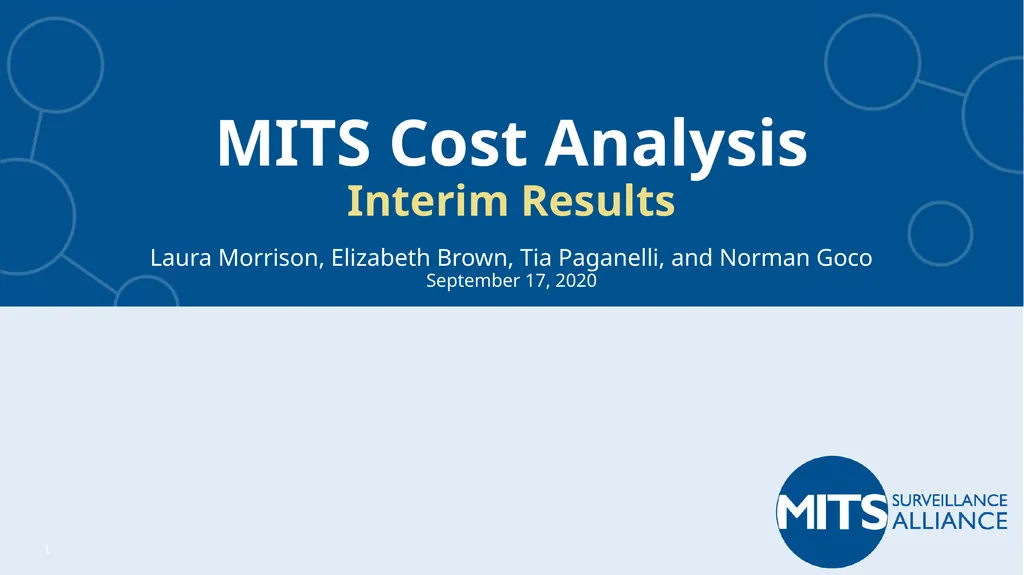MITS Cost Analysis Interim Results Laura Morrison,
Author : alida-meadow | Published Date : 2025-06-23
Description: MITS Cost Analysis Interim Results Laura Morrison Elizabeth Brown Tia Paganelli and Norman Goco September 17 2020 1 Building the evidence base for MITS Adoption of MITS in LMICs can improve the amount of and quality of COD data thus
Presentation Embed Code
Download Presentation
Download
Presentation The PPT/PDF document
"MITS Cost Analysis Interim Results Laura Morrison," is the property of its rightful owner.
Permission is granted to download and print the materials on this website for personal, non-commercial use only,
and to display it on your personal computer provided you do not modify the materials and that you retain all
copyright notices contained in the materials. By downloading content from our website, you accept the terms of
this agreement.
Transcript:MITS Cost Analysis Interim Results Laura Morrison,:
MITS Cost Analysis Interim Results Laura Morrison, Elizabeth Brown, Tia Paganelli, and Norman Goco September 17, 2020 1 Building the evidence base for MITS Adoption of MITS in LMICs can improve the amount of and quality of COD data, thus improving the epidemiological knowledge base, and informing effective interventions for preventing mortality. To promote expansion of MITS, must evaluate validity, acceptability, feasibility, and cost-effectiveness. (Byass 2016) This study is an initial step towards understanding cost implications. Cost studies of novel practices (1) advocate for widespread adoption and (2) inform realistic implementation. Building the evidence base for MITS What is agreed upon related to costs of MITS? That they must be better understood. (Byass 2016) MITS and MIA cost documentation and comparison studies in high-income countries exist, but may not be relevant for LMIC contexts. (Weustink et al, 2009; Breeze et al, 2010) Cost of specific supplies (biopsy needles), requirement of complex and costly microbiology platforms and microbiology specialists/pathologists are limitations to MIA in Mozambique (Castillo et al, 2015) Perceived high cost of MITS among HCWs in Pakistan (Feroz et al, 2019) May require public investment Operational expenses < initial investment cost Study Objective Characterize the costs and cost drivers associated with MITS implementation in LMIC settings from the health care provider perspective. Implementation costs estimate MITS’ operational requirements only (no research costs). The provider’s perspective represents costs that clinics/hospitals or health care systems would face in expanding/mainstreaming the use of MITS. Cost Data Collection Interim results draw from a cost survey of four sites conducted between Feb - June 2020. Sites are geographically dispersed Sites are recipients of MITS Alliance grant funding Sites must have conducted MITS outside of training Cost survey delivered during in-person site visits, by e-mail; follow ups via phone interview. Pilots identified all relevant resources used (in-person site visits) Data collected from sites include: context-specific site information financial and economic data related to resources used in MITS implementation Cost estimation INITIAL INVESTMENT COST RECURRING COST INCREMENTAL COST (PER CASE) Sampling Community collection (if applicable) Testing Test transport (if applicable) Materials (e.g. reagents, office + lab supplies) MITS kits (materials, labor, shipping) Labor (staff compensation) PROGRAM ADMINISTRATION COST (ANNUAL) Labor (staff compensation) Materials (e.g. office supplies, meetings, internet) Cost estimation not included in interim results RECURRING COST Cost estimation CAPITAL COSTS Lab equipment Office furniture Technology Renovation expenses START-UP COSTS initial training + training additional staff (labor,













